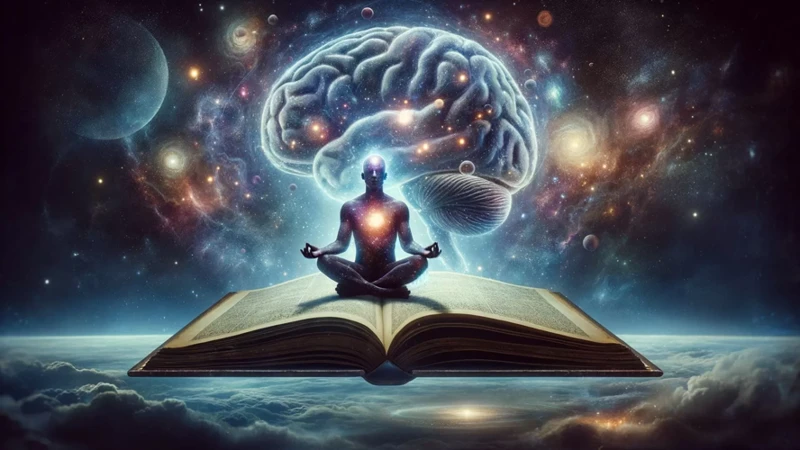Introduction: The Mysteries of Dreams

Dreams have long been a subject of fascination and intrigue for humans throughout history. We are often left bewildered by the unexplainable images and feelings that occur in our dreams, as they transport us to a realm beyond our conscious reality. The phenomenon of dreaming has captured the attention of philosophers, psychologists, and spiritual leaders, sparking countless theories and interpretations.
Some people view dreams as mere random neural firings during sleep, while others believe they hold deeper meanings and messages from the subconscious or even the spiritual realm. Regardless of these differing perspectives, one thing remains certain – dreams have a profound impact on our lives.
Throughout this article, we will embark on a journey to unravel the hidden meanings of dreams and explore the various dimensions they encompass. We will dive into the power of dreams, the symbolism they contain, the subconscious mind’s role in creating them, and how they can serve as messages from the spiritual realm. We will also delve into common dream themes, the process of dream interpretation, and how dreams can be harnessed for personal growth and manifestation.
So, let us venture into the enigmatic landscape of dreams, where the boundaries of reality are blurred, and the mysteries of our subconscious minds are waiting to be unveiled. In the words of Martin Luther King Jr., “I have a dream”. Let us now embark on a journey to discover the world we dream about.
The Power of Dreams

Dreams possess a powerful influence over our lives, shaping our thoughts, emotions, and experiences. They have the ability to transport us to other dimensions, allowing us to explore our deepest desires, fears, and aspirations. Dreams have the potential to ignite our imagination, reveal hidden truths, and provide us with profound insights into ourselves and the world around us.
One of the most intriguing aspects of dreams is their capacity to tap into our subconscious mind. When we dream, our conscious barriers dissolve, allowing repressed memories, unexpressed emotions, and unresolved conflicts to surface. Dreams serve as a gateway to our innermost thoughts and feelings, giving us an opportunity to process and understand them in ways that may not be accessible during waking hours.
Dreams also have a therapeutic effect on our mental, emotional, and physical well-being. They can act as a release valve for stress, allowing us to work through anxieties and traumas. Additionally, dreams can provide guidance and inspiration, helping us find creative solutions to problems or navigate challenging situations.
Dreams are not limited to the boundaries of our individual selves. They can connect us to a collective consciousness, where shared symbols and archetypes unite us in a universal dream language. Through our dreams, we may tap into a larger web of meaning and understanding, connecting us to something greater than ourselves.
As we unravel the power of dreams in this journey, we will explore the symbolism within them, the role of the subconscious mind, and how dreams can serve as messages from the spiritual realm. By delving into the depths of our dreams, we open ourselves to a world of wisdom, insight, and self-discovery. So, let us continue our exploration into the mysteries of the dream realm and uncover the hidden meanings that lie within.
Understanding Symbolism in Dreams

Symbolism in dreams holds the key to unraveling the hidden messages that lie within. Dreams often speak to us in a language of symbols, using imagery and metaphors to convey deeper meanings. These symbols can range from common objects to fantastical creatures, each holding a unique significance in the dreamer’s personal context. Understanding the symbolism in dreams requires a deep exploration of one’s own subconscious mind and the collective unconscious that connects us all. By delving into the symbols present in our dreams, we can gain valuable insights into our emotions, desires, and fears. Dreams provide a rich tapestry of symbols waiting to be deciphered, inviting us to embark on a journey of self-discovery and transformation. So, let us dive into the enigmatic realm of dream symbolism and unlock the mysteries that lie within.
The Language of Dream Symbols
In the realm of dreams, symbolism emerges as a powerful form of communication. Just as words hold meaning in our waking lives, symbols convey messages in the language of dreams. These symbols can be objects, people, animals, or even abstract concepts that carry significance beyond their literal representation.
Interpreting the language of dream symbols requires a nuanced understanding of the context and personal associations that each symbol holds. While some symbols may have universal meanings, such as water representing emotions or a snake symbolizing transformation, the interpretation of symbols is highly subjective and can vary from person to person.
To unlock the meanings behind dream symbols, it is essential to explore our personal connections and experiences. For example, if you frequently dream about flying, it may represent a sense of freedom and liberation for you. For others, it might symbolize a desire for escape or the exploration of new possibilities.
Dream dictionaries and guides can provide general interpretations of common symbols, but they should be used as a starting point for personal exploration rather than rigid truths. Engaging in self-reflection and journaling about the emotions, thoughts, and experiences associated with specific symbols can help unveil deeper meanings unique to each individual.
By delving into the language of dream symbols, we gain insight into the hidden messages and desires encoded within our dreams. Understanding these symbols allows us to tap into the vast wisdom of our subconscious minds and embark on a journey of self-discovery and personal growth. So, let us now decipher the intricate codes of the dream realm and uncover the profound meanings that lie within the symbols of our dreams.
Common Dream Symbols and Interpretations
When we unravel the mysteries of our dreams, one aspect that captivates us is the symbolism embedded within them. Dream symbols are like a language of their own, conveying deeper meanings and messages. While the interpretation of dream symbols can vary based on an individual’s personal experiences and emotions, there are certain common symbols that often appear in dreams and hold significant interpretations.
One common dream symbol is water, which is often associated with emotions. Calm and clear water can signify tranquility and peace, while turbulent or murky water may represent emotional turmoil or uncertainty.
Another prevalent symbol is flying, which is often linked to a feeling of liberation, transcendence, or the desire for freedom. Dreaming about flying may suggest a longing to break free from limitations or explore new possibilities.
Animals also frequently appear in dreams, each carrying its own symbolic meaning. For example, a snake is often associated with transformation or hidden knowledge, while a dog may symbolize loyalty and companionship.
Dreams involving falling can be quite common and are often associated with a loss of control or a fear of failure. These dreams may reflect insecurities or anxieties about certain aspects of life.
It’s important to note that while these common dream symbols provide a foundation for interpretation, the true meaning of a dream symbol can vary depending on the context of the dream as well as the individual’s personal associations. To gain a deeper understanding of our dreams, it is crucial to take into account our own unique experiences, emotions, and subconscious patterns.
By exploring and deciphering the meanings behind these common dream symbols, we can unlock valuable insights into our own psyche and gain a better understanding of ourselves. So, let us delve further into the fascinating world of dream symbols and interpretations as we continue our journey of dream exploration.
Dreams and the Subconscious Mind

The realm of dreams serves as a gateway to our subconscious mind, a mysterious and powerful reservoir of our deepest thoughts, desires, and emotions. While we may not always be aware of it, our subconscious mind influences our conscious thoughts and actions, and it is during our dreams that it can truly express itself. Dreams provide a canvas for our subconscious to paint vivid imagery and create narratives that reflect our innermost fears, anxieties, and aspirations. When we dream, we tap into a realm where the limitations of the waking world are lifted, allowing our subconscious mind to communicate with us in symbolic and metaphorical ways. Exploring the connection between dreams and the subconscious mind provides a fascinating insight into our true selves and can lead to profound self-discovery and personal growth. So, let’s embark on this intriguing journey where we dive deep into the enigmatic realm of dreams and the secrets held within our subconscious mind.
The Role of the Subconscious in Dreaming
The subconscious mind plays a central role in the creation and interpretation of our dreams. It serves as a reservoir of thoughts, memories, and emotions that are not readily accessible to our conscious awareness. While our conscious mind is active during waking hours, our subconscious mind continues to work behind the scenes, processing information, and generating dreams that reflect our innermost desires, fears, and conflicts.
During sleep, when the conscious mind takes a step back, the subconscious mind takes the spotlight, allowing buried thoughts and emotions to rise to the surface. In the realm of dreams, the subconscious mind can freely express itself, creating a symbolic language that speaks to us in metaphors and images.
The subconscious mind does not abide by logical or linear thinking, which is why dreams often appear strange and nonsensical upon waking. Yet, hidden beneath the bizarre narratives and surreal landscapes lie profound meanings and insights waiting to be deciphered.
Dreams provide a window into our subconscious mind, offering us a glimpse into our deepest motivations, unresolved issues, and unexpressed desires. They can reveal patterns in our thoughts and behaviors that may be influencing our waking life, allowing us to gain a better understanding of ourselves and make positive changes.
As we delve into the interpretation of dreams, we will explore the symbols and themes that emerge from the subconscious. We will uncover how dreams can help us unearth hidden emotions, process traumatic experiences, and unlock new perspectives on ourselves and the world we inhabit.
So, let us continue our exploration of the subconscious mind and its role in shaping the fascinating landscape of our dreams. Through understanding the workings of the subconscious, we can begin to unravel the mysteries of our dreams and gain valuable insights into our innermost selves.
Uncovering Hidden Emotions and Desires
Understanding the intricacies of our dreams can lead us on a path of self-discovery, allowing us to uncover hidden emotions and desires that may be buried within our subconscious minds. Dreams serve as a canvas for the expression of our deepest hopes, fears, and longings, offering valuable insights into our true selves.
When we analyze our dreams, we can start to unravel the symbolism and imagery that often represent our underlying emotions and desires. The vivid landscapes, characters, and events that unfold while we sleep can act as metaphors for aspects of our waking lives that we may not be consciously aware of.
For example, dreaming about water may symbolize our emotions and the depths of our psyche. Dreaming about flying could represent a desire for freedom or a need to rise above challenges. These symbolic elements can serve as clues in deciphering the hidden messages that our dreams are trying to convey.
By unraveling the symbolism in our dreams, we gain a deeper understanding of ourselves. We become aware of suppressed emotions and desires that may need acknowledgment and attention in our waking lives. Dreams can provide us with the opportunity to confront and explore these hidden aspects of ourselves, leading to personal growth and emotional healing.
In our quest to interpret our dreams, we can utilize various techniques and tools such as journaling, dream analysis, and seeking guidance from experts in the field. The process of uncovering hidden emotions and desires through dream interpretation requires patience, introspection, and a willingness to delve into the depths of our psyche.
So let us embrace the enigmatic nature of our dreams and embark on a journey of self-discovery. By peering into the depths of our dreams, we can gain valuable insights into our hidden emotions and desires, guiding us towards a more authentic and fulfilling life.
Lucid Dreaming: Navigating the Dream Realm

Lucid dreaming is a remarkable phenomenon that allows individuals to become aware of and navigate the dream realm with a sense of consciousness and control. In a lucid dream, one realizes that they are in a dream state and can actively participate in shaping the dream experience. This unique ability opens up a world of possibilities for personal growth, exploration, and even problem-solving. Lucid dreaming has been studied and practiced by many, who utilize techniques such as reality checks, dream journaling, and meditation to enhance their lucid dreaming skills. When lucid, individuals can engage in extraordinary adventures, interact with dream characters, and even practice new skills. Through the art of lucid dreaming, we can tap into the depths of our subconscious mind and harness the potential of our dreams. So, join us as we delve into the realm of lucid dreaming and discover the limitless possibilities that await us in this domain of consciousness.
Awareness and Control in Lucid Dreams
In the realm of dreams, there exists a fascinating phenomenon known as lucid dreaming, where the dreamer becomes aware that they are in a dream and gains the ability to exert control over the dream narrative. Lucid dreams offer a unique opportunity to explore and interact with the dream world with a heightened sense of consciousness.
When one becomes aware within a dream, a sense of empowerment and freedom emerges. The dreamer realizes that they are not bound by the limitations of the physical world and can actively shape their dreamscape. With practice, individuals can develop techniques to increase their lucidity and control over the dream environment.
Awareness in lucid dreams can be achieved through various methods, such as reality checks, setting intentions before sleep, or keeping a dream journal. These practices help to cultivate a conscious mindset that carries over into the dream state. Once lucidity is established, the dreamer can engage in a range of activities, from flying through the sky to conversing with dream characters.
Control in lucid dreams allows individuals to manipulate their dream reality according to their desires. They can change the scenery, summon objects or people, and even alter the laws of physics in their dream world. The possibilities are limited only by the dreamer’s imagination and belief in their ability to shape the dream environment.
Lucid dreams not only provide an exhilarating and immersive experience but can also have practical applications. Some individuals use lucid dreaming as a tool for personal growth, self-exploration, and overcoming fears. By confronting challenging situations within the safety of a dream, they can develop confidence and resilience in waking life.
In the next section, we will delve deeper into the potential for personal growth through lucid dreaming. We will explore how lucid dreams can be utilized as a means for self-discovery, problem-solving, and spiritual exploration. So, let us enter the realm of lucidity and unlock the possibilities that lie within our dreams.
Utilizing Lucid Dreams for Personal Growth
Utilizing Lucid Dreams for Personal Growth:
Lucid dreaming, where an individual becomes aware that they are dreaming while still in the dream state, offers a unique opportunity for personal growth and exploration. When we have control over our dreams, we can actively engage with them, shaping the narrative and experiences within. This level of awareness allows us to tap into our subconscious mind and harness the power of our dreams for personal development.
1. Self-Reflection and Insight: Lucid dreams provide a platform for introspection, allowing us to delve deeper into our thoughts, beliefs, and emotions. By consciously exploring our dreams, we can gain valuable insights into our patterns, fears, and desires, helping us to better understand ourselves and make positive changes in our waking lives.
2. Overcoming Fears and Limitations: Lucid dreaming offers a safe environment to confront and overcome fears, phobias, and limitations. With the awareness that we are in a dream, we can face our fears head-on, gradually desensitizing ourselves and building confidence in the process. This newfound sense of empowerment may then extend beyond the dream realm and impact our waking lives.
3. Creative Exploration: Lucid dreams provide a playground for creativity and imagination. In this altered state of consciousness, we can experiment with different scenarios, explore new ideas, and find innovative solutions to problems. Lucid dreaming can be a wellspring of inspiration for artists, writers, and innovators, serving as a fertile ground for creative exploration.
4. Skill Enhancement and Practice: Lucid dreaming can be utilized as a platform for skill development and practice. Athletes can mentally rehearse their performances, musicians can fine-tune their techniques, and learners can reinforce their knowledge, all within the construct of a lucid dream. This practice within dreams has been shown to have a positive impact on subsequent real-life performance.
By utilizing lucid dreams for personal growth, we can expand our self-awareness, overcome obstacles, and tap into our untapped potential. Through intentional exploration and active engagement within the dream realm, we have the opportunity to cultivate a deeper understanding of ourselves and manifest positive change in our waking lives. So, let us dive into the realm of lucid dreaming and unlock the transformative potential that lies within.
Dreams as Messages: Insights from the Spiritual Realm

Dreams have long been regarded as a channel through which we receive messages from the spiritual realm. The enigmatic nature of dreams allows us to tap into a deeper level of consciousness, where symbolism and metaphor combine to convey profound insights. When we dream, we may encounter spiritual beings, receive guidance from higher powers, or experience vivid imagery that carries spiritual significance. These dreams can provide us with valuable wisdom, spiritual lessons, and a deeper understanding of ourselves and the world. Whether it’s a dream about a loved one who has passed away, a visitation from a divine figure, or a symbolic representation of our spiritual journey, these messages from the spiritual realm offer us opportunities for growth, healing, and connection to something greater than ourselves. As we explore the realm of dreams and their spiritual significance, we open ourselves to a world of mystery, wonder, and spiritual enlightenment.
Connecting with the Divine through Dreams
Connecting with the divine through dreams is a profound and spiritual experience that transcends the boundaries of our waking reality. It is believed that dreams can serve as a bridge between our earthly existence and the realm of the divine. In these sacred dream encounters, we may receive messages, guidance, and inspiration from higher beings or the divine presence.
Throughout history, many spiritual traditions and cultures have recognized the significance of dreams in establishing a connection with the divine. In ancient civilizations, dreams were considered direct communication with the gods or ancestors. Shamans and spiritual leaders often relied on dreams to receive wisdom and insights for healing and guidance.
When we connect with the divine in our dreams, we may experience encounters with celestial beings, receive prophetic visions, or engage in profound conversations with spiritual figures. These divine messages can offer us direction, solace, and a deep sense of purpose. They can provide clarity on our life path or bring forth teachings that allow us to grow spiritually and understand our place in the universe.
It is important to approach these divine encounters in dreams with reverence and open-mindedness. Cultivating practices such as meditation, prayer, and mindfulness can create a receptive space for these sacred connections. Keeping a dream journal and reflecting on the symbolism and messages within our dreams can also deepen our understanding of these divine interactions.
As we delve further into the exploration of dreams, we will continue to uncover the ways in which dreams can connect us with the divine. We will explore techniques for interpreting spiritual messages in dreams and how to navigate the sacred realm of dreams. So, let us embrace the wisdom that comes from connecting with the divine through our dreams and invite the presence of the divine into our dreamscapes.
Interpreting Spiritual Messages in Dreams
Interpreting spiritual messages in dreams is a fascinating process that can provide profound insights into our spiritual journey and connection with the divine. When we experience dreams that contain spiritual symbolism or messages, it means that our subconscious mind is trying to communicate with us on a deeper level.
One key aspect of interpreting spiritual messages in dreams is paying attention to the symbols and imagery that appear. These symbols can hold personal significance and may have deep-rooted meanings in spiritual traditions or belief systems. For example, encountering an eagle in a dream could represent a symbol of spiritual strength or guidance. By analyzing these symbols and their contextual relevance to our own lives, we can begin to decipher the spiritual messages embedded within our dreams.
Another important factor in interpreting spiritual messages is considering the feelings and emotions experienced during the dream. Dreams can evoke a wide range of emotions, from joy and peace to fear and uncertainty. These emotions can provide valuable clues about our spiritual state, inner conflicts, or areas of growth that may require attention.
Additionally, it’s essential to take into account any recurring patterns or themes in our dreams, as these can also carry spiritual significance. The repetition of certain symbols or scenarios may indicate that our spiritual guides or higher consciousness is trying to convey an important message or lesson.
Dreams that contain spiritual messages can serve as a catalyst for personal growth and transformation. They can provide us with guidance, encouragement, and inspiration on our spiritual path. By embracing and actively seeking to understand these messages, we open ourselves to a deeper understanding of ourselves, our purpose, and our connection to something greater.
So, the next time you have a dream that feels spiritually significant, take a moment to reflect on the symbols, emotions, and recurring themes present. Consider journaling about your dreams, practicing meditation or prayer, and engaging in self-reflection to deepen your interpretation of the spiritual messages they hold. Embrace the wisdom that comes from unraveling the mysteries of these dreams, and allow them to enrich your spiritual journey.
Common Dream Themes and Their Meanings

Dreams often present us with various common themes, each carrying its own unique symbolism and meaning. These recurring motifs can provide valuable insight into our subconscious desires, fears, and emotions. One prevalent theme is flying and falling dreams, which typically represent a sense of freedom, empowerment, or a lack of control in waking life. Another common theme is nightmares, which can reflect deep-seated anxieties or unresolved traumas. Coping strategies for nightmares include relaxation techniques, facing fears, and seeking professional support if needed. Recurring dreams are another intriguing theme, as they often point towards persistent patterns in our lives that need attention and resolution. By keeping a dream journal and reflecting on these recurring symbols, we can gain a deeper understanding of ourselves and work towards personal growth and healing. So, let us delve into these common dream themes and explore the hidden meanings they hold, guiding us on our journey towards self-discovery and transformation.
Flying and Falling Dreams
Flying and falling dreams are some of the most common and intriguing dream experiences. They often evoke a mix of excitement, exhilaration, and fear. These dreams can symbolize a range of emotions, desires, and challenges that we encounter in our waking lives.
Flying Dreams:
Flying dreams are often associated with a sense of freedom, liberation, and empowerment. In these dreams, we soar through the skies, effortlessly gliding above the world below. Flying can represent a release from constraints, a desire for independence, or a need to escape from a difficult or challenging situation. It can also symbolize a sense of achievement, accomplishment, or the ability to overcome obstacles. Flying dreams can leave us with a feeling of awe and wonder, as if we’ve tapped into our own inner strength and potential. (Link: Do You Dream About Me?)
Falling Dreams:
Falling dreams, on the other hand, often evoke a sense of vulnerability, loss of control, or fear of failure. These dreams typically involve a sensation of descending rapidly, whether from a great height or off a cliff. Falling can symbolize a lack of stability or security in our lives, a fear of letting go, or a sense of insecurity or self-doubt. It may also represent a fear of failure or fear of the unknown. While falling dreams can be unsettling, they can also serve as a reminder to face our fears, confront our insecurities, and find ways to regain control in our waking lives. (Link: What Happens If You Dream About Dying?)
Both flying and falling dreams offer valuable insights into our emotions, aspirations, and obstacles. They provide us with an opportunity to explore our inner desires for freedom and security, and they can serve as powerful metaphors for our own personal growth and transformation. By understanding the symbolism within these dreams, we can gain a deeper understanding of ourselves and our waking experiences. Let us now embark on an exploration of other common dream themes and their meanings.
Nightmare Interpretation and Coping Strategies
Nightmares can be incredibly distressing and leave us feeling unsettled long after we wake up. However, it’s important to remember that nightmares often carry symbolic messages from our subconscious mind and shouldn’t be dismissed as mere frightening experiences. By interpreting and understanding these nightmares, we can gain valuable insights into our inner fears, anxieties, and unresolved conflicts.
When it comes to nightmare interpretation, it’s crucial to pay attention to the emotions and symbols present in the dream. Nightmares frequently represent hidden or repressed fears and traumas, giving us an opportunity to confront and address these underlying issues. By exploring the meaning behind the symbols and events in the nightmare, we can uncover deep-rooted emotions and belief patterns that may require attention and healing.
Coping strategies play a vital role in dealing with nightmares. One effective approach is to create a peaceful and soothing bedtime routine that promotes relaxation and reduces anxiety before sleep. Engaging in activities such as reading a calming book, practicing meditation or deep breathing exercises, or listening to soothing music can help create an environment conducive to a more peaceful sleep.
Another coping strategy is to confront the nightmare head-on. By embracing the fear within the nightmare and exploring its origins, we can gain a sense of empowerment and control over the situation. Techniques such as lucid dreaming, where we become aware that we are dreaming and can actively influence the dream’s outcome, can be particularly helpful.
Seeking support from a therapist or counselor who specializes in dream analysis can also be beneficial. They can provide guidance and insight into the underlying causes of the nightmares and assist in developing coping mechanisms tailored to individual needs.
Remember, nightmares are not meant to torment us but rather to guide us towards healing and growth. By interpreting and addressing the messages they convey, we can transform these frightening experiences into opportunities for self-discovery and personal development. So, let us delve deeper into the realm of nightmares and uncover their hidden meanings, gathering the tools we need to navigate these powerful dreams.
Recurring Dreams: Unlocking the Persistent Patterns
Recurring dreams are a fascinating aspect of the dream realm that often leave us pondering their significance. These persistent dreams that recur over time carry valuable insights and messages that are waiting to be deciphered. Unlocking the patterns and symbolism within recurring dreams can provide us with a deeper understanding of our subconscious mind and its desires, fears, and unresolved issues.
When we experience recurring dreams, it is essential to pay attention to the common elements or themes present across these dreams. These recurring patterns may hold clues about unresolved emotions or situations in our lives that need our attention. By identifying these patterns, we can begin the process of unraveling their meaning and uncovering the underlying message.
Exploring recurring dreams often requires introspection and reflection. Keeping a dream journal can be immensely helpful in analyzing the details of each occurrence. By documenting the recurring dreams, we can observe any subtle changes or developments, as well as the emotions they evoke within us. This practice allows us to track our progress in understanding and resolving the persistent patterns.
In interpreting recurring dreams, it is important to consider the context of our waking life. Paying attention to any parallels or similarities between our dreams and our real-life experiences can provide valuable insights. It may be helpful to explore any unresolved issues, interpersonal conflicts, or emotional challenges that may be reflected in the recurring dreams. By addressing these underlying issues, we can work towards resolving them and potentially alleviate the recurrence of these dreams.
As we continue our exploration into the mysteries of recurring dreams, we will discuss common themes and symbols that often appear, such as falling, flying, or being chased. We will delve into potential interpretations and coping strategies for dealing with recurring nightmares, as well as techniques for breaking free from the persistent patterns they present.
Recurring dreams offer us an opportunity for self-reflection and growth. By unlocking the persistent patterns within these dreams, we gain valuable insights into ourselves and can take steps towards creating positive change in our waking lives. So, let us delve deeper into the mysterious world of recurring dreams and uncover the wisdom they hold.
Keeping a Dream Journal: Unearthing Patterns and Recurring Symbols

Keeping a dream journal is an invaluable tool for unlocking the hidden messages and patterns within our dreams. By recording our dreams upon waking, we create a sacred space to delve deeper into their meanings and symbols.
Unearthing Patterns: A dream journal allows us to identify recurring themes, symbols, and emotions that appear across multiple dreams. By documenting these patterns, we can start to unravel the hidden messages that our subconscious mind is trying to convey. Patterns may emerge in the form of specific locations, settings, people, or even objects that regularly appear in our dreams. Through the process of journaling, we can begin to understand the significance of these patterns and their connection to our waking lives.
Recurring Symbols: Dreams often communicate through symbols, utilizing metaphorical representations of our thoughts, emotions, and experiences. By maintaining a dream journal, we can identify and analyze these symbols, unraveling their personal meaning to us. For example, a dream about flying could symbolize feelings of freedom or empowerment, while a dream about being chased might signify avoidance or fear. Each individual may have unique associations with symbols, and a dream journal helps us uncover these personal interpretations.
In your dream journal, write down as much detail as possible about the dream, including the setting, characters, events, and emotions experienced. Reflect on the overall mood and atmosphere of the dream. Pay close attention to any recurring themes or symbols that appear across multiple dreams. By organizing this information, such as in a table or list format, you can easily compare and analyze the patterns that emerge.
As you delve into your dream journal, you may find surprising connections between your dreams and your waking life. By understanding the recurring symbols and patterns, you gain a deeper understanding of your subconscious mind and its influence on your thoughts, feelings, and actions. So, take the time to document your dreams and unlock the wisdom they hold. For further insight, you can also explore Martin Luther King Jr.’s iconic “I Have a Dream” speech, which delves into the power of dreams and their ability to inspire change and transformation.
Harnessing the Power of Dream Interpretation

Dream interpretation holds the key to unlocking the profound wisdom contained within our dreams. By harnessing the power of dream analysis, we can delve into the depths of our subconscious minds and gain valuable insights into ourselves and our lives. This process involves examining the symbols, emotions, and themes that arise in our dreams and deciphering their meaning. Through techniques such as journaling, meditation, and seeking professional guidance, we can develop a greater understanding of our dreams and how they relate to our waking experiences. Dream interpretation is a personal and transformative journey that enables us to tap into our deepest desires, fears, and aspirations, ultimately leading to personal growth and self-discovery. So, let us embrace the power of dream interpretation and embark on a path of self-exploration, just as Martin Luther King Jr. did when he delivered his iconic “I Have a Dream” speech, envisioning a world filled with equality, justice, and harmony.
Techniques for Analyzing and Interpreting Dreams
When it comes to analyzing and interpreting dreams, there are various techniques that can be employed to uncover their hidden meanings and messages. These techniques serve as tools to navigate the intricate landscape of the dream realm and gain insights into our subconscious mind. Here are some effective techniques for analyzing and interpreting dreams:
1. Journaling: Keeping a dream journal is a fundamental technique for understanding our dreams. Upon waking, immediately write down any details, symbols, emotions, or impressions from the dream. This helps capture the essence of the dream before it fades from memory and allows for reflection and analysis later on. The act of journaling can also uncover patterns, recurring symbols, or themes in our dreams over time.
2. Symbolism Analysis: Dreams often communicate through symbols, which carry layers of meaning. Analyzing and interpreting these symbols can unveil the subconscious messages within dreams. Create a list of symbols from the dream and explore their possible meanings. Consider personal associations, cultural symbolism, and archetypal representations. Reflect on how each symbol relates to your own life and experiences.
3. Contextual Interpretation: Dreams do not exist in isolation; they are influenced by our waking life experiences and emotions. Analyzing the context of the dream, including the setting, people, and events, can provide valuable insights into its interpretation. Reflect on any connections between the dream and your current circumstances, relationships, or emotions.
4. Emotional Exploration: Emotions experienced during dreams often hold significant meaning. Consider the emotions felt in the dream and explore their connection to your waking life. Pay attention to any unresolved or repressed emotions that may be surfacing in the dream. These emotions can serve as guideposts for understanding underlying issues or desires.
5. Theories and Resources: Familiarize yourself with different theories and resources on dream analysis, such as Freudian or Jungian concepts. Explore books, online resources, or dream analysis experts who offer frameworks for understanding dreams. However, remember that dreams are deeply personal, and interpretation should be tailored to your unique experiences and perspectives.
By employing these techniques, we can delve deeper into the rich symbolism, emotions, and narratives that our dreams offer. They help us unlock the hidden messages and tap into the wisdom of our subconscious mind. So, grab your dream journal and let’s embark on an exciting journey of self-discovery through the art of dream analysis.
Utilizing Dream Analysis for Personal Growth
Dream analysis is a powerful tool for personal growth, allowing us to gain valuable insights into our subconscious mind and uncover the hidden meanings behind our dreams. By engaging in the process of analyzing our dreams, we can unlock a wealth of knowledge and understanding that can profoundly impact our lives.
One way to utilize dream analysis for personal growth is to keep a dream journal. Recording our dreams immediately upon waking helps us capture the details and emotions experienced during the dream state. By consistently documenting our dreams, we can start to identify patterns, recurring symbols, and themes that may hold significant meaning for us.
Once we have a collection of recorded dreams, we can begin to analyze them for deeper insights. This involves examining the symbolism within the dreams and exploring their potential connections to our waking life. Dreams often contain metaphors and representations of our subconscious desires, fears, and unresolved issues. By decoding these symbols, we can gain a better understanding of ourselves and the areas in our lives that require attention or growth.
Another approach to dream analysis is to engage in conversations or consultations with experts, such as psychologists or dream therapists. These professionals can provide guidance and interpretation based on their knowledge and experience. They may offer alternative perspectives and shed light on aspects of the dream that we may have overlooked.
Dream analysis for personal growth also involves reflecting on the emotions and feelings evoked by our dreams. By paying attention to how we felt during the dream and upon waking, we can delve into the underlying emotions that may be influencing our thoughts and behaviors in our waking life. This self-reflection can lead to a heightened sense of self-awareness, allowing us to make positive changes and work towards personal growth.
Incorporating the practice of dream analysis into our lives can be transformative. By embracing the wisdom and messages that our dreams offer, we open ourselves up to self-discovery, healing, and personal development. So, let us delve into the world of dream analysis and harness its power for our own personal growth and transformation.
Dreams and Manifestation: Creating the World We Dream Of
Dreams have the power to do more than just provide insight and understanding; they can also be a catalyst for manifestation. When we tap into the realm of our dreams, we are tapping into a source of boundless creativity and inspiration. By paying attention to the symbols and messages within our dreams, we can use them to set intentions and goals for our waking lives. Dreams can serve as a guide, showing us the path to bring our desires into reality. Whether it’s a career aspiration, a personal relationship, or a vision for a better world, our dreams have the ability to shape our thoughts and actions, aligning them with the world we dream of. Just like Martin Luther King Jr.’s “I have a dream” speech that called for equality and justice, our dreams can be the driving force behind positive change and transformation. By harnessing the power of our dreams, we can ultimately create the world we aspire to see.
Using Dreams as Inspiration for Goal Setting
Dreams have the remarkable ability to provide us with inspiration and guidance, especially when it comes to goal setting. When we pay attention to our dreams, we may uncover hidden desires, passions, and aspirations that we might not have consciously recognized. By using dreams as a source of inspiration, we can align our goals with our deepest innermost desires and work towards creating a life that truly resonates with us.
One way to harness the power of dreams for goal setting is to keep a dream journal. By recording our dreams upon waking, we can capture the vivid details, emotions, and symbols that arise during the dream state. These dream entries can then serve as a rich source of inspiration when setting goals. Patterns and recurring themes within our dreams can shed light on our subconscious desires and help us identify areas of our lives that need attention or development.
Dreams can also provide a glimpse into the possibilities and potential outcomes of our goals. They can offer us insights into the challenges we may face along the way and guide us towards the necessary steps we need to take to achieve our desired outcomes. Paying attention to the emotions we experience in our dreams can also inform us whether a particular goal truly resonates with our authentic selves.
Dr. Martin Luther King Jr. famously shared his dream of equality and freedom in his historic speech, “I Have a Dream”. His dream served as inspiration for a monumental social movement. Similarly, when we use our own dreams as inspiration for goal setting, we tap into a wellspring of motivation and passion that can propel us towards our desired future.
So, let us remember the power of our dreams in shaping our goals. Utilize them as a source of inspiration, guidance, and motivation as we embark on our own personal journeys of growth and achievement. By aligning our goals with our dreams, we move closer to living a life that reflects our truest aspirations and deepest desires.
Dreaming Big: Turning Dreams into Reality
Turning dreams into reality is the ultimate manifestation of our aspirations and desires. Dreaming big is all about envisioning a future that surpasses our current reality and taking the necessary steps to bring that vision to life. It is about embracing the power of our dreams and using them as a driving force to create meaningful change in our lives.
When we dream big, we tap into our innate potential and challenge the limitations that society or ourselves may have placed upon us. We dare to defy the odds and pursue our passions with unwavering determination. Dreaming big requires us to think beyond what is comfortable or familiar, and to expand our horizons to encompass the possibilities that lie beyond our imagination.
To turn dreams into reality, we must first define our goals and establish a clear vision for what we want to achieve. This involves setting specific, measurable, achievable, relevant, and time-bound (SMART) objectives that propel us towards our dreams. With a well-defined plan in place, we can take consistent action and make deliberate choices that align with our dreams and aspirations.
Dreaming big also requires perseverance and resilience. There will inevitably be obstacles and setbacks along the way, but it is through these challenges that we grow and develop the skills necessary to overcome them. It is important to stay committed to our dreams, even when faced with adversity or self-doubt. Remember the words of Martin Luther King Jr. in his iconic “I Have a Dream” speech, where he envisioned a world free from racial discrimination and inequality.
By turning our dreams into reality, we not only create a fulfilling life for ourselves but also inspire others to pursue their own dreams. Our actions serve as a testament to the power of dreaming big and the limitless possibilities that lie within each of us. So, let us embrace our dreams, believe in our potential, and take bold steps towards turning our dreams into reality.
Conclusion: Embrace the Wisdom of Our Dreams
Our dreams hold a wealth of wisdom and insight that can enrich our lives if we choose to embrace them. They serve as a portal to our subconscious mind, unraveling hidden emotions, desires, and fears. By understanding the symbolism within our dreams, we can decipher their messages and gain a deeper understanding of ourselves.
Dreams have the power to guide us on our personal growth journey. Through dream analysis and interpretation, we can uncover patterns, recurring symbols, and persistent themes that serve as signposts for self-discovery and transformation. Keeping a dream journal allows us to track our dreams over time, unearthing valuable insights and connecting the dots between our dreams and waking life.
Dreams provide a direct line of communication with the spiritual realm. They can serve as a channel through which the divine speaks to us, offering guidance, inspiration, and clarity. By honing our ability to interpret spiritual messages in dreams, we open ourselves to a deeper connection with the universal energies that surround us.
It is through the power of dreams that we can manifest the world we desire. By harnessing the inspiration and guidance found within our dreams, we can set goals, aspire to greatness, and turn our dreams into reality. Dreams provide us with the fuel to dream big, to envision a better world, and to take action in pursuit of our dreams.
So, as we embrace the wisdom of our dreams, let us remember the words of Martin Luther King Jr. and the enduring legacy of his “I Have a Dream” speech. Just as he dared to dream of a world free from injustice and inequality, we too can dare to dream and work towards creating a better world for ourselves and future generations.
Let us cherish the mysteries of our dreams and honor their profound impact on our lives. By venturing into the realm of dreams, we embark on a transformative journey of self-discovery, growth, and manifestation. So, dream boldly, interpret fearlessly, and unlock the hidden treasures that lie within the world we dream about.
Frequently Asked Questions
FAQs about Dream Interpretation
1. What is dream interpretation?
Dream interpretation is the process of analyzing the symbols, emotions, and experiences within a dream to uncover its hidden meanings and messages.
2. Why do we dream?
The exact purpose of dreaming is still a mystery, but it is believed that dreams serve various functions such as processing emotions, consolidating memories, and providing insights into our subconscious mind.
3. Are dreams influenced by real-life experiences?
Yes, dreams often incorporate elements from our waking life such as events, people, and emotions. These real-life experiences can shape the content and themes of our dreams.
4. Can dreams predict the future?
While some people claim to have had prophetic dreams, the ability of dreams to predict the future is still highly debated. Dreams are more commonly seen as symbolic representations of our thoughts, emotions, and experiences.
5. What should I do if I have a disturbing dream?
Disturbing dreams can be unsettling, but it’s important not to jump to conclusions or panic. Instead, take some time to reflect on the emotions and symbols in the dream and consider seeking guidance from a therapist or dream expert if needed.
6. Do recurring dreams have a specific meaning?
Recurring dreams often indicate unresolved issues or patterns in our lives. They can serve as reminders to pay attention to certain aspects of ourselves or situations that we may need to address.
7. Can I control my dreams?
With practice, some individuals can develop the ability to have lucid dreams, where they become aware that they are dreaming and can exert some level of control within the dream.
8. What is the role of emotions in dreams?
Emotions in dreams can range from joy and happiness to fear and anxiety. Exploring the emotions present in a dream can provide valuable insights into our subconscious feelings and thoughts.
9. Are there universal dream symbols?
While there are common symbols that many people may relate to, the interpretation of dream symbols is highly personal and can vary depending on an individual’s cultural background, experiences, and personal associations.
10. Is dream interpretation a scientific process?
Dream interpretation combines elements of psychology, symbolism, and personal associations. While it is not considered a strictly scientific process, it can provide valuable insights and self-reflection.







